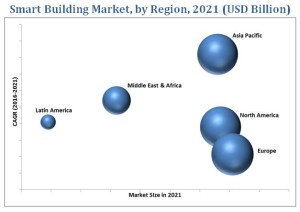Building management systems (BMS) play key role in security, surveillance and lighting systems of a particular building. In modern times, information technology is playing a vital role in shaping the future of the conventional building management systems. Known by the name of smart automation, today’s management systems of the buildings have advanced to great levels. Buildings enabled with these systems are known as smart buildings. The rising adoption of these systems across the world is driving the smart building market at an impressive rate. According to the experts, the global market for smart building automation will continue its progress for the next four to five years to come. Advancements in technology are also attributed to the upward growth of the industry.

The global smart building market size to grow from an estimated USD 7.42 billion in 2017 to USD 31.74 billion by 2022, at a Compound Annual Growth Rate (CAGR) of 33.7% during the period 2017–2022. The major drivers for the increase in demand in the smart building market include the implementation of the IoT platform in building automation technology and the growing need for integrated security and safety systems.
The scope of this report covers an analysis of the smart building market by type, building type, and region. By type is further segmented into building automation and services. By building type is further segmented into manufacturing facilities, residential buildings, commercial buildings, university, school & hospital buildings, government & public infrastructure facilities, and others. Based on region, the smart building market has been segmented into North America, Europe, Asia Pacific, Middle East & Africa, and Latin America. Moreover, the demand for smart buildings is increasing across various industry verticals due to the decreasing operational costs and increasing government initiatives for smart building projects.
Based on type, the services segment is projected to grow at the highest CAGR during the forecast period. This is due to the offer of services such as consultation & training, integration, and support by the major players to maintain their share in the market. These services are considered as added offerings from technology vendors and service providers in the smart infrastructure ecosystem, which enhance the deployment and usage of solutions at end user premises. Additionally, service providers for smart buildings help in implementing intelligent automation and technologies for the efficient operation and maintenance of buildings in a cost-effective manner.
On the basis of building type, the residential building segment is expected to grow at the highest CAGR during the forecast period. This is due to the ability of communication standards and protocols to integrate various control devices and minimize the use of wires due to the emergence of wireless technologies.
On the basis of regional analysis, the Asia Pacific is expected to grow at a higher CAGR in the smart building market during the forecast period. This is due the development of smart city projects across this region. Countries such as China, India, Australia, and Singapore have launched the initial phases of smart building projects. Also, the growing use of cloud based as well as IoT technologies and increasing strategic alliances among technology vendors are encouraging governments to undertake initiatives for the development of smart and green buildings
